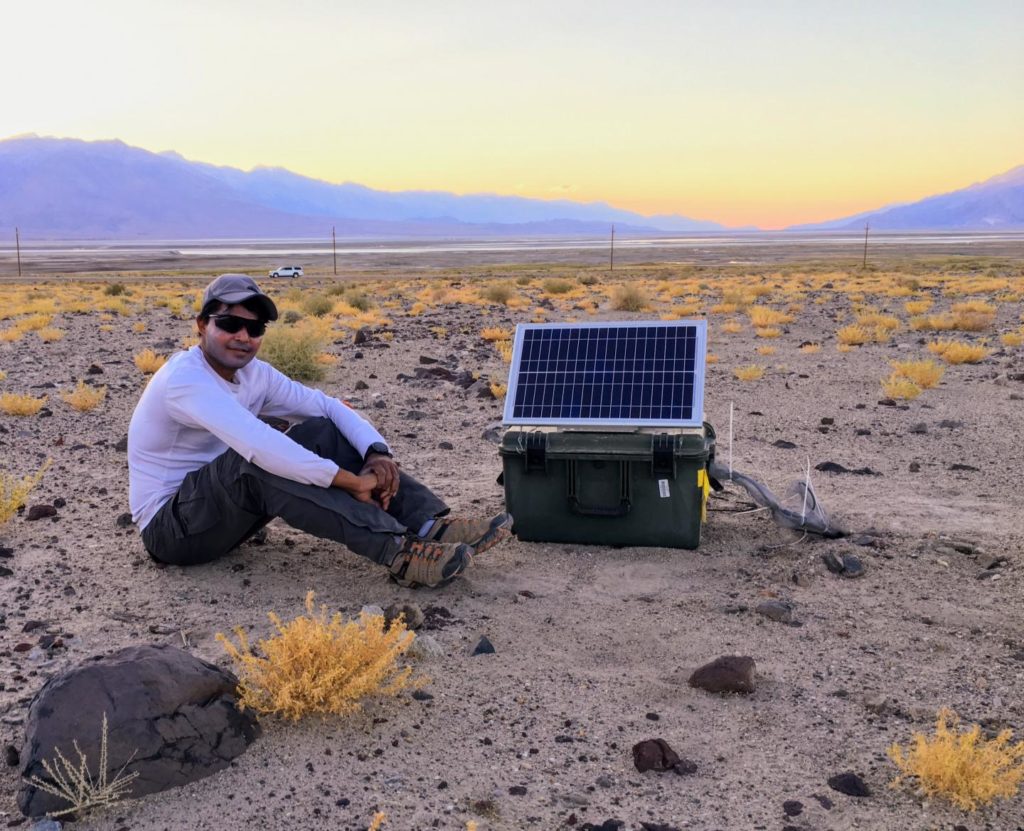The fault underneath the town of Ridgecrest, California, has no name because scientists did not discover it until the 7.1 magnitude earthquake it produced on July 5.
Now,
Abhijit Ghosh
, an associate professor of geophysics at UC Riverside, is racing to understand everything he can about the unnamed fault to help officials prepare for the next big shake.
His study is aided by a new grant from the National Science Foundation which began Aug. 1 and will enable him to track aftershocks in the area of the 7.1 for one year.
“It’s not a matter of ‘whether’ there will be another large quake in California,” Ghosh said, “It’s an inevitability. The more we understand about the physics behind earthquakes, the better we can prepare to combat their hazards.”
On July 6, Ghosh drove to Ridgecrest and installed the first in a series of 25 seismometers in the ground that are measuring thousands of aftershocks in the area.
“These instruments are extremely sensitive,” Ghosh said. “They can detect and locate even very tiny earthquakes very precisely.”
Five UCR geophysics graduate students helped install this temporary network of seismometers: Andrew Birkey, Baoning Wu, Kuntal Chaudhuri, Matt Mendoza, and Shankho Niyogi.
Information these machines provide about the size, location and time of the aftershocks will help Ghosh map the structure of the fault in three dimensions and understand the evolution of stress within it that led to the big earthquake. Then he’ll be able to answer some important research questions.
The first question: Did the 6.4 magnitude earthquake on July 4 set off the 7.1 in Ridgecrest the next day? The earlier event occurred on separate faults that are perpendicular to one another. Beyond that information, Ghosh said it is not yet known how they interacted.
Faults are typically structured with rock plates that either slip past one another horizontally or vertically. Mapping the faults and understanding their structures can explain how or whether stress transferred from one to the other.
A second question Ghosh seeks to answer is about how the 7.1 has affected other faults. The nearby Garlock fault is about 150 miles long and part of it sits roughly 30 miles outside of Bakersfield.
Because the length of a fault determines the magnitude of an earthquake, stress to Garlock could be dangerous.
“If Garlock goes, it will create a much larger event than Ridgecrest, which is estimated to be only about 40 miles long,” Ghosh said. Though he does not want to create undue alarm, Ghosh noted that aftershocks are touching Garlock in the north, and that it has been more active since Ridgecrest.
While some people believe that an earthquake eases tension on a fault making a subsequent event less likely, Ghosh said this is a myth. A magnitude 5.0 quake today doesn’t reduce the possibility of the same fault having an 8.0 tomorrow. However, Ghosh said because the Ridgecrest fault is relatively small, it is possible that the 7.1 is the largest event it can produce.
Ghosh, who is available for media interviews, studies earthquakes to help combat the hazards associated with large quakes, and eventually work on more effective warning systems.
“Be prepared,” Ghosh said. “Seismic hazard levels are high in California, whether you live near Ridgecrest or not.”
He advises keeping an earthquake kit with supplies to sustain yourself for several days, as well as a designated meeting place to find loved ones in case you are separated.
“Most importantly, people need to know what to do during strong shaking,” Ghosh said. In addition to staying away from door frames and staying put while the ground is shaking, he offers the following advice.
“Drop under something sturdy, cover your vital organs, and if you’re under a table or desk hold on to the legs,” Ghosh said. “That way the shelter is likely to move with you, keeping you safer from falling objects.”
###
Jules Bernstein
951-827-4580
Jules.Bernstein@ucr.edu
http://www.ucr.edu
